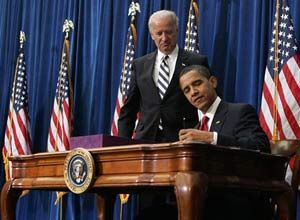
By Jerry Brant

AP Photo/Darin McGregor Vice President Joe Biden stands behind President Barack Obama as he signs the $787 billion economic stimulus bill in Denver last month. |
|
Related Resources:
Stimulus funding: What you need to know Fire station, wildland funding included in approved stimulus plan Financial Crisis and the Fire Service |
Why? Because the fire service has never in a unified voice painted a very dramatic picture of what would happen if we weren’t around. The negative effect this would have on property values and the crisis it would cause in the insurance and financial services industries needs to be vocalized.
If this is starting to sound like a very recent message used by someone else to get billions, then you see what I mean. The important lesson to be learned here is we need to get our message out in a clear, concise, factual manner whether it's for our grant application or for a public relations campaign.
How to initiate this
You need to develop a demographic profile of your coverage area and your department. Begin with US Census data which you can access
Census.gov
. Once you reach the site, click on "census 2000," followed by "access data by geography." You can then type in your state and municipality, which will bring up a compilation of data about your community.
Continue to do this for all of the municipalities in your first due coverage area. Next, depending on your preference, either download it or print it out and put it into a binder. This is the start of your profile.
Visit your planning commission
I believe every state requires their transportation and/or public utility agencies to compile 10 and 20-year planning documents, which are available through your planning commission. A section of these plans will discuss anticipated areas of development and their projected rates of growth. If any of these zones are in your first due coverage area, make a note of them for future use.
Your area's employment outlook should be your next concern. Again, your planning commission or the Bureau of Labor Statistics are good sources for you to check. At a minimum know your community's unemployment rate and check it monthly as new figures are posted. Additionally, either of theses sources may also provide information on employment sectors that are anticipating imminent growth.
After that, delve into any relevant information that's available at your department such as your ISO Public Protection Classification and the date this survey was conducted. And what SARA facilities and critical infrastructure components are in your first due area?
Information on every call
Begin compiling as much information as you can on every call you answer. At a minimum, document how many members responded, what apparatus was used, the length of the call, the mileage traveled to get to the call, and any mutual aid required. Then have someone in your department start to record this information so that you can pull statistics from it as needed.
 Each year we witness drastic increases in the cost of daily operations and a reduced amount of available local funding.
Each year we witness drastic increases in the cost of daily operations and a reduced amount of available local funding.

|
||
|
|
||
But this process does show how much the fire service has needed to evolve over the past few decades and respond to new challenges. This June, I will celebrate 40 years in the fire service. I have spent this period with two volunteer departments in rural west–central Pennsylvania. When I joined, a new engine built by a prominent manufacturer cost about $30,000.
Equipment revenue
Our revenue to purchase new equipment was derived from bingo, dances, festivals and the annual fund drive, which featured a coin card that was mailed to each household. The cards encouraged residents to put a quarter a week in each premarked slot. Residents could either return the filled cards to our station or we would canvas the community later in the year to collect any remaining cards. A quarter a week over the 10-month period raised $10 a card. So all you needed was 3,000 returned cards and you could buy a new engine.
We responded to at least 100 calls a year at that time. These were structure fires, chimney fires, brush fires, false alarms and a very occasional vehicle accident. There were no lift assists, forcible entries or calls for trees or wires down. No one was concerned about tanker trucks carrying life-threatening hazardous materials. Also, there was no federal financial help government and only very minor assistance from our state government.
Fast forward to today and we in the fire service are now dispatched to deal with just about every conceivable type of situation. We are on the front line for response to natural disasters, manmade calamities and even terrorist attacks. Each year we witness drastic increases in the cost of daily operations and a reduced amount of available local funding.
Today a new engine costs $400,000. Using my old formula, that $10 fund drive contribution now needs to be increased to $134 from each resident. I don't believe any of us have seen this type of an increase in individual donations or tax revenue recently.
It’s no surprise then that every department is out looking for assistance from the government, foundations, and other sources, but guess what, so is every other organization from schools, to libraries and to private businesses.
It's your job to ensure your message is heard.
If you have any suggestions you would like to share or any topics you would like to have featured in this column, please e-mail me at
Jerry.Brant@FireRescue1.com
.
Copyright © 2025 FireGrantsHelp.com. All rights reserved.